Environmental Sustainable Development Report: An ISO 14001 Analysis
VerifiedAdded on 2022/08/13
|9
|3238
|13
Report
AI Summary
This report provides a comprehensive analysis of environmental sustainable development, focusing on the implementation of an Environmental Management System (EMS) within a company. It addresses hazardous chemical management, emphasizing the need for a proactive approach to environmental protection and compliance with regulations. The report details the application of ISO 14001:2015 principles, including the formation of environmental policy and adherence to relevant legislation in Singapore. It outlines the Environmental Impact Assessment (EIA) process, from preliminary activities to final decision-making, and discusses the significance of this process from both external and internal perspectives. The report also covers the environmental audit process, including the stages involved in verifying the EMS's conformity. Furthermore, it provides insights into risk assessment, mitigation strategies, and the importance of corporate social responsibility for long-term sustainability.
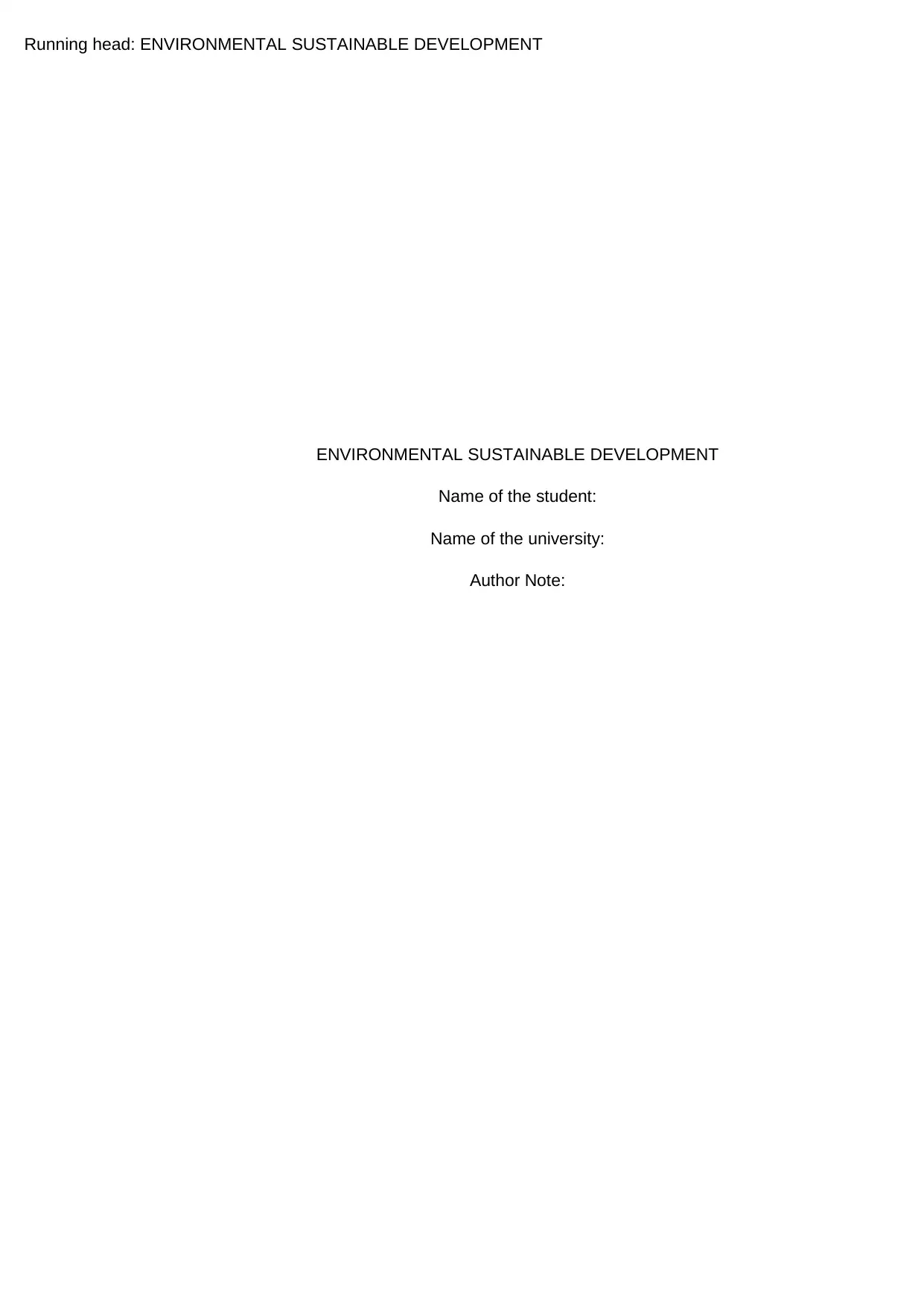
Running head: ENVIRONMENTAL SUSTAINABLE DEVELOPMENT
ENVIRONMENTAL SUSTAINABLE DEVELOPMENT
Name of the student:
Name of the university:
Author Note:
ENVIRONMENTAL SUSTAINABLE DEVELOPMENT
Name of the student:
Name of the university:
Author Note:
Paraphrase This Document
Need a fresh take? Get an instant paraphrase of this document with our AI Paraphraser
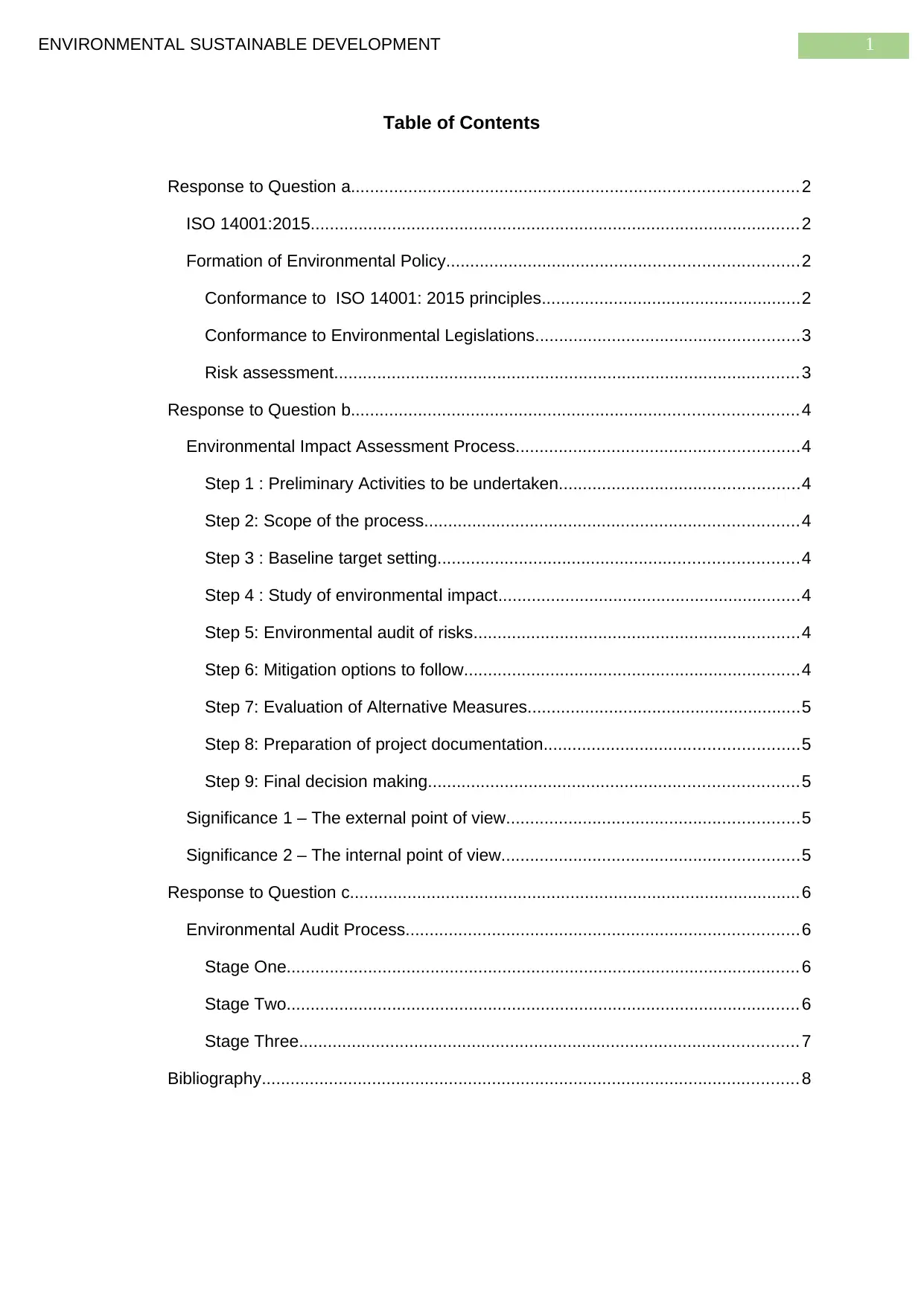
1ENVIRONMENTAL SUSTAINABLE DEVELOPMENT
Table of Contents
Response to Question a.............................................................................................2
ISO 14001:2015......................................................................................................2
Formation of Environmental Policy.........................................................................2
Conformance to ISO 14001: 2015 principles......................................................2
Conformance to Environmental Legislations.......................................................3
Risk assessment.................................................................................................3
Response to Question b.............................................................................................4
Environmental Impact Assessment Process...........................................................4
Step 1 : Preliminary Activities to be undertaken..................................................4
Step 2: Scope of the process..............................................................................4
Step 3 : Baseline target setting...........................................................................4
Step 4 : Study of environmental impact...............................................................4
Step 5: Environmental audit of risks....................................................................4
Step 6: Mitigation options to follow......................................................................4
Step 7: Evaluation of Alternative Measures.........................................................5
Step 8: Preparation of project documentation.....................................................5
Step 9: Final decision making.............................................................................5
Significance 1 – The external point of view.............................................................5
Significance 2 – The internal point of view..............................................................5
Response to Question c..............................................................................................6
Environmental Audit Process..................................................................................6
Stage One...........................................................................................................6
Stage Two...........................................................................................................6
Stage Three........................................................................................................7
Bibliography................................................................................................................ 8
Table of Contents
Response to Question a.............................................................................................2
ISO 14001:2015......................................................................................................2
Formation of Environmental Policy.........................................................................2
Conformance to ISO 14001: 2015 principles......................................................2
Conformance to Environmental Legislations.......................................................3
Risk assessment.................................................................................................3
Response to Question b.............................................................................................4
Environmental Impact Assessment Process...........................................................4
Step 1 : Preliminary Activities to be undertaken..................................................4
Step 2: Scope of the process..............................................................................4
Step 3 : Baseline target setting...........................................................................4
Step 4 : Study of environmental impact...............................................................4
Step 5: Environmental audit of risks....................................................................4
Step 6: Mitigation options to follow......................................................................4
Step 7: Evaluation of Alternative Measures.........................................................5
Step 8: Preparation of project documentation.....................................................5
Step 9: Final decision making.............................................................................5
Significance 1 – The external point of view.............................................................5
Significance 2 – The internal point of view..............................................................5
Response to Question c..............................................................................................6
Environmental Audit Process..................................................................................6
Stage One...........................................................................................................6
Stage Two...........................................................................................................6
Stage Three........................................................................................................7
Bibliography................................................................................................................ 8
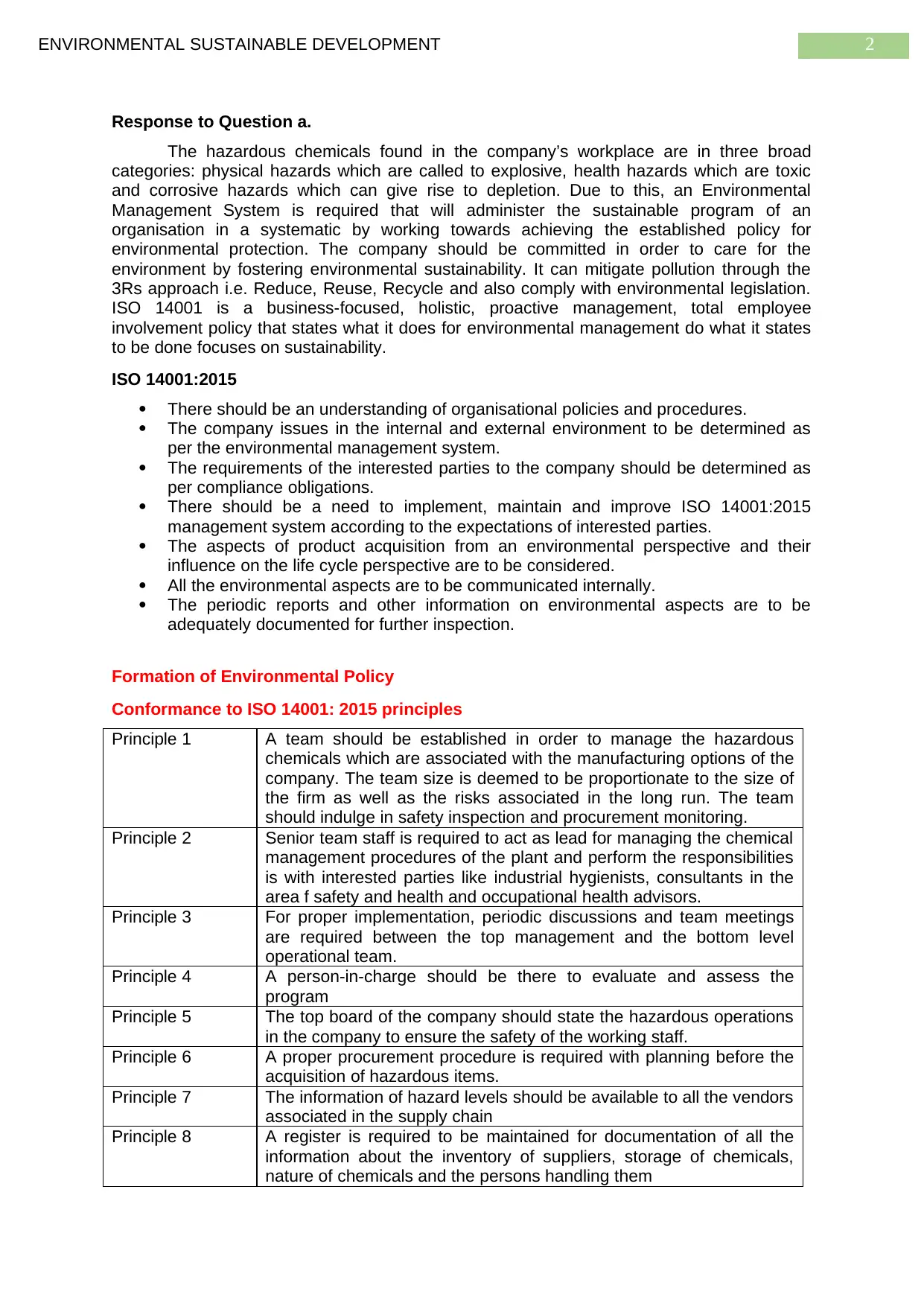
2ENVIRONMENTAL SUSTAINABLE DEVELOPMENT
Response to Question a.
The hazardous chemicals found in the company’s workplace are in three broad
categories: physical hazards which are called to explosive, health hazards which are toxic
and corrosive hazards which can give rise to depletion. Due to this, an Environmental
Management System is required that will administer the sustainable program of an
organisation in a systematic by working towards achieving the established policy for
environmental protection. The company should be committed in order to care for the
environment by fostering environmental sustainability. It can mitigate pollution through the
3Rs approach i.e. Reduce, Reuse, Recycle and also comply with environmental legislation.
ISO 14001 is a business-focused, holistic, proactive management, total employee
involvement policy that states what it does for environmental management do what it states
to be done focuses on sustainability.
ISO 14001:2015
There should be an understanding of organisational policies and procedures.
The company issues in the internal and external environment to be determined as
per the environmental management system.
The requirements of the interested parties to the company should be determined as
per compliance obligations.
There should be a need to implement, maintain and improve ISO 14001:2015
management system according to the expectations of interested parties.
The aspects of product acquisition from an environmental perspective and their
influence on the life cycle perspective are to be considered.
All the environmental aspects are to be communicated internally.
The periodic reports and other information on environmental aspects are to be
adequately documented for further inspection.
Formation of Environmental Policy
Conformance to ISO 14001: 2015 principles
Principle 1 A team should be established in order to manage the hazardous
chemicals which are associated with the manufacturing options of the
company. The team size is deemed to be proportionate to the size of
the firm as well as the risks associated in the long run. The team
should indulge in safety inspection and procurement monitoring.
Principle 2 Senior team staff is required to act as lead for managing the chemical
management procedures of the plant and perform the responsibilities
is with interested parties like industrial hygienists, consultants in the
area f safety and health and occupational health advisors.
Principle 3 For proper implementation, periodic discussions and team meetings
are required between the top management and the bottom level
operational team.
Principle 4 A person-in-charge should be there to evaluate and assess the
program
Principle 5 The top board of the company should state the hazardous operations
in the company to ensure the safety of the working staff.
Principle 6 A proper procurement procedure is required with planning before the
acquisition of hazardous items.
Principle 7 The information of hazard levels should be available to all the vendors
associated in the supply chain
Principle 8 A register is required to be maintained for documentation of all the
information about the inventory of suppliers, storage of chemicals,
nature of chemicals and the persons handling them
Response to Question a.
The hazardous chemicals found in the company’s workplace are in three broad
categories: physical hazards which are called to explosive, health hazards which are toxic
and corrosive hazards which can give rise to depletion. Due to this, an Environmental
Management System is required that will administer the sustainable program of an
organisation in a systematic by working towards achieving the established policy for
environmental protection. The company should be committed in order to care for the
environment by fostering environmental sustainability. It can mitigate pollution through the
3Rs approach i.e. Reduce, Reuse, Recycle and also comply with environmental legislation.
ISO 14001 is a business-focused, holistic, proactive management, total employee
involvement policy that states what it does for environmental management do what it states
to be done focuses on sustainability.
ISO 14001:2015
There should be an understanding of organisational policies and procedures.
The company issues in the internal and external environment to be determined as
per the environmental management system.
The requirements of the interested parties to the company should be determined as
per compliance obligations.
There should be a need to implement, maintain and improve ISO 14001:2015
management system according to the expectations of interested parties.
The aspects of product acquisition from an environmental perspective and their
influence on the life cycle perspective are to be considered.
All the environmental aspects are to be communicated internally.
The periodic reports and other information on environmental aspects are to be
adequately documented for further inspection.
Formation of Environmental Policy
Conformance to ISO 14001: 2015 principles
Principle 1 A team should be established in order to manage the hazardous
chemicals which are associated with the manufacturing options of the
company. The team size is deemed to be proportionate to the size of
the firm as well as the risks associated in the long run. The team
should indulge in safety inspection and procurement monitoring.
Principle 2 Senior team staff is required to act as lead for managing the chemical
management procedures of the plant and perform the responsibilities
is with interested parties like industrial hygienists, consultants in the
area f safety and health and occupational health advisors.
Principle 3 For proper implementation, periodic discussions and team meetings
are required between the top management and the bottom level
operational team.
Principle 4 A person-in-charge should be there to evaluate and assess the
program
Principle 5 The top board of the company should state the hazardous operations
in the company to ensure the safety of the working staff.
Principle 6 A proper procurement procedure is required with planning before the
acquisition of hazardous items.
Principle 7 The information of hazard levels should be available to all the vendors
associated in the supply chain
Principle 8 A register is required to be maintained for documentation of all the
information about the inventory of suppliers, storage of chemicals,
nature of chemicals and the persons handling them
⊘ This is a preview!⊘
Do you want full access?
Subscribe today to unlock all pages.

Trusted by 1+ million students worldwide
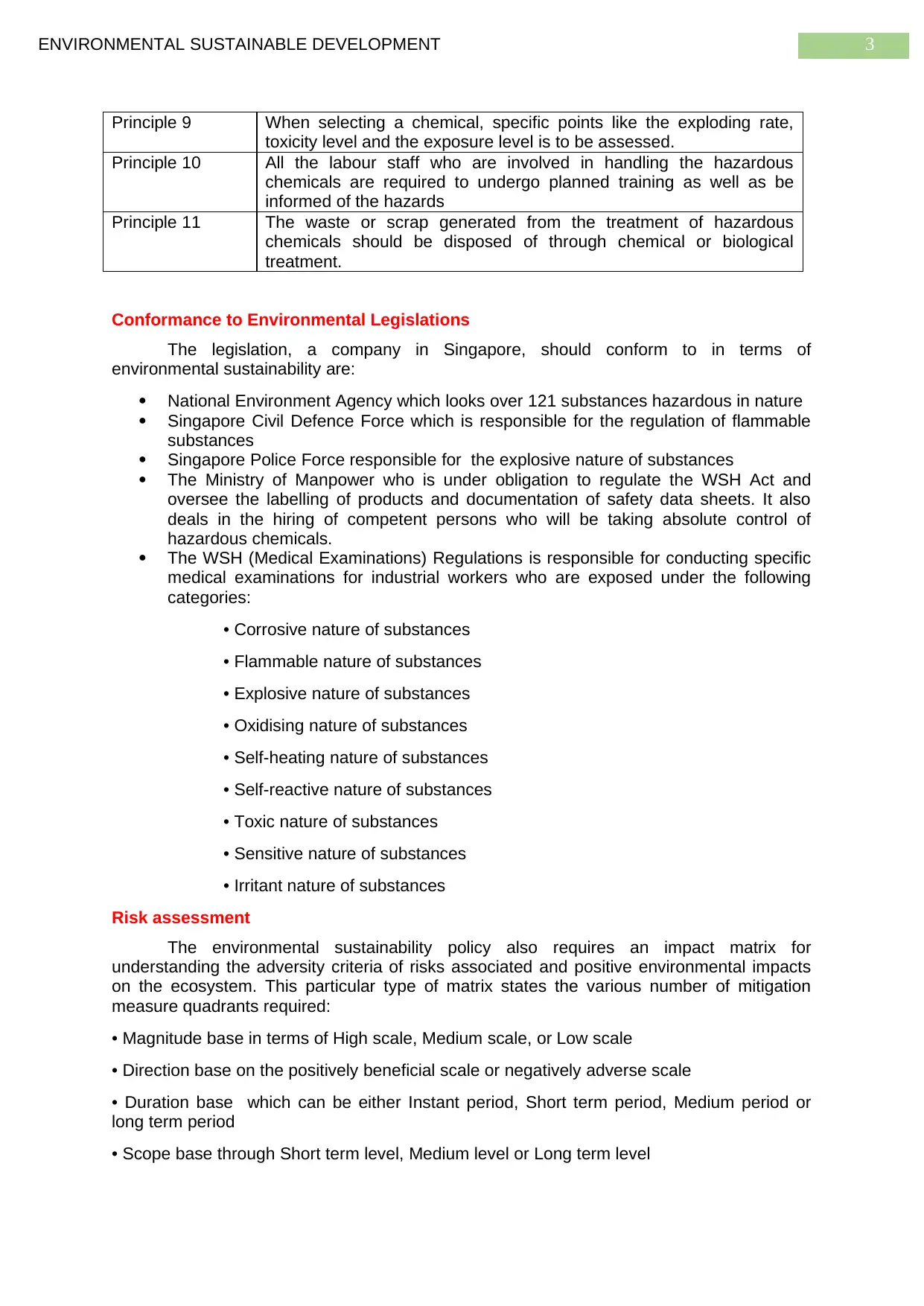
3ENVIRONMENTAL SUSTAINABLE DEVELOPMENT
Principle 9 When selecting a chemical, specific points like the exploding rate,
toxicity level and the exposure level is to be assessed.
Principle 10 All the labour staff who are involved in handling the hazardous
chemicals are required to undergo planned training as well as be
informed of the hazards
Principle 11 The waste or scrap generated from the treatment of hazardous
chemicals should be disposed of through chemical or biological
treatment.
Conformance to Environmental Legislations
The legislation, a company in Singapore, should conform to in terms of
environmental sustainability are:
National Environment Agency which looks over 121 substances hazardous in nature
Singapore Civil Defence Force which is responsible for the regulation of flammable
substances
Singapore Police Force responsible for the explosive nature of substances
The Ministry of Manpower who is under obligation to regulate the WSH Act and
oversee the labelling of products and documentation of safety data sheets. It also
deals in the hiring of competent persons who will be taking absolute control of
hazardous chemicals.
The WSH (Medical Examinations) Regulations is responsible for conducting specific
medical examinations for industrial workers who are exposed under the following
categories:
• Corrosive nature of substances
• Flammable nature of substances
• Explosive nature of substances
• Oxidising nature of substances
• Self-heating nature of substances
• Self-reactive nature of substances
• Toxic nature of substances
• Sensitive nature of substances
• Irritant nature of substances
Risk assessment
The environmental sustainability policy also requires an impact matrix for
understanding the adversity criteria of risks associated and positive environmental impacts
on the ecosystem. This particular type of matrix states the various number of mitigation
measure quadrants required:
• Magnitude base in terms of High scale, Medium scale, or Low scale
• Direction base on the positively beneficial scale or negatively adverse scale
• Duration base which can be either Instant period, Short term period, Medium period or
long term period
• Scope base through Short term level, Medium level or Long term level
Principle 9 When selecting a chemical, specific points like the exploding rate,
toxicity level and the exposure level is to be assessed.
Principle 10 All the labour staff who are involved in handling the hazardous
chemicals are required to undergo planned training as well as be
informed of the hazards
Principle 11 The waste or scrap generated from the treatment of hazardous
chemicals should be disposed of through chemical or biological
treatment.
Conformance to Environmental Legislations
The legislation, a company in Singapore, should conform to in terms of
environmental sustainability are:
National Environment Agency which looks over 121 substances hazardous in nature
Singapore Civil Defence Force which is responsible for the regulation of flammable
substances
Singapore Police Force responsible for the explosive nature of substances
The Ministry of Manpower who is under obligation to regulate the WSH Act and
oversee the labelling of products and documentation of safety data sheets. It also
deals in the hiring of competent persons who will be taking absolute control of
hazardous chemicals.
The WSH (Medical Examinations) Regulations is responsible for conducting specific
medical examinations for industrial workers who are exposed under the following
categories:
• Corrosive nature of substances
• Flammable nature of substances
• Explosive nature of substances
• Oxidising nature of substances
• Self-heating nature of substances
• Self-reactive nature of substances
• Toxic nature of substances
• Sensitive nature of substances
• Irritant nature of substances
Risk assessment
The environmental sustainability policy also requires an impact matrix for
understanding the adversity criteria of risks associated and positive environmental impacts
on the ecosystem. This particular type of matrix states the various number of mitigation
measure quadrants required:
• Magnitude base in terms of High scale, Medium scale, or Low scale
• Direction base on the positively beneficial scale or negatively adverse scale
• Duration base which can be either Instant period, Short term period, Medium period or
long term period
• Scope base through Short term level, Medium level or Long term level
Paraphrase This Document
Need a fresh take? Get an instant paraphrase of this document with our AI Paraphraser
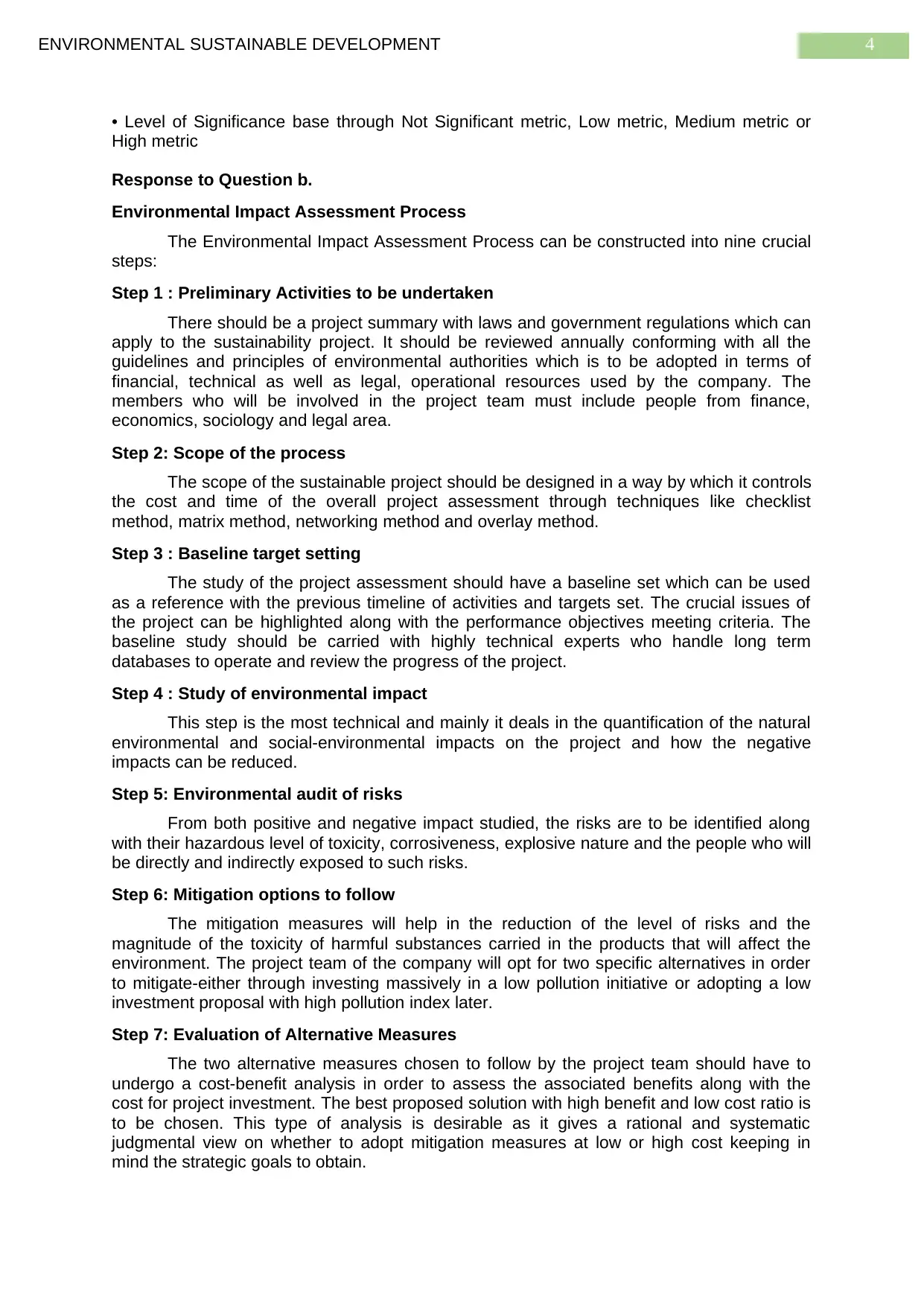
4ENVIRONMENTAL SUSTAINABLE DEVELOPMENT
• Level of Significance base through Not Significant metric, Low metric, Medium metric or
High metric
Response to Question b.
Environmental Impact Assessment Process
The Environmental Impact Assessment Process can be constructed into nine crucial
steps:
Step 1 : Preliminary Activities to be undertaken
There should be a project summary with laws and government regulations which can
apply to the sustainability project. It should be reviewed annually conforming with all the
guidelines and principles of environmental authorities which is to be adopted in terms of
financial, technical as well as legal, operational resources used by the company. The
members who will be involved in the project team must include people from finance,
economics, sociology and legal area.
Step 2: Scope of the process
The scope of the sustainable project should be designed in a way by which it controls
the cost and time of the overall project assessment through techniques like checklist
method, matrix method, networking method and overlay method.
Step 3 : Baseline target setting
The study of the project assessment should have a baseline set which can be used
as a reference with the previous timeline of activities and targets set. The crucial issues of
the project can be highlighted along with the performance objectives meeting criteria. The
baseline study should be carried with highly technical experts who handle long term
databases to operate and review the progress of the project.
Step 4 : Study of environmental impact
This step is the most technical and mainly it deals in the quantification of the natural
environmental and social-environmental impacts on the project and how the negative
impacts can be reduced.
Step 5: Environmental audit of risks
From both positive and negative impact studied, the risks are to be identified along
with their hazardous level of toxicity, corrosiveness, explosive nature and the people who will
be directly and indirectly exposed to such risks.
Step 6: Mitigation options to follow
The mitigation measures will help in the reduction of the level of risks and the
magnitude of the toxicity of harmful substances carried in the products that will affect the
environment. The project team of the company will opt for two specific alternatives in order
to mitigate-either through investing massively in a low pollution initiative or adopting a low
investment proposal with high pollution index later.
Step 7: Evaluation of Alternative Measures
The two alternative measures chosen to follow by the project team should have to
undergo a cost-benefit analysis in order to assess the associated benefits along with the
cost for project investment. The best proposed solution with high benefit and low cost ratio is
to be chosen. This type of analysis is desirable as it gives a rational and systematic
judgmental view on whether to adopt mitigation measures at low or high cost keeping in
mind the strategic goals to obtain.
• Level of Significance base through Not Significant metric, Low metric, Medium metric or
High metric
Response to Question b.
Environmental Impact Assessment Process
The Environmental Impact Assessment Process can be constructed into nine crucial
steps:
Step 1 : Preliminary Activities to be undertaken
There should be a project summary with laws and government regulations which can
apply to the sustainability project. It should be reviewed annually conforming with all the
guidelines and principles of environmental authorities which is to be adopted in terms of
financial, technical as well as legal, operational resources used by the company. The
members who will be involved in the project team must include people from finance,
economics, sociology and legal area.
Step 2: Scope of the process
The scope of the sustainable project should be designed in a way by which it controls
the cost and time of the overall project assessment through techniques like checklist
method, matrix method, networking method and overlay method.
Step 3 : Baseline target setting
The study of the project assessment should have a baseline set which can be used
as a reference with the previous timeline of activities and targets set. The crucial issues of
the project can be highlighted along with the performance objectives meeting criteria. The
baseline study should be carried with highly technical experts who handle long term
databases to operate and review the progress of the project.
Step 4 : Study of environmental impact
This step is the most technical and mainly it deals in the quantification of the natural
environmental and social-environmental impacts on the project and how the negative
impacts can be reduced.
Step 5: Environmental audit of risks
From both positive and negative impact studied, the risks are to be identified along
with their hazardous level of toxicity, corrosiveness, explosive nature and the people who will
be directly and indirectly exposed to such risks.
Step 6: Mitigation options to follow
The mitigation measures will help in the reduction of the level of risks and the
magnitude of the toxicity of harmful substances carried in the products that will affect the
environment. The project team of the company will opt for two specific alternatives in order
to mitigate-either through investing massively in a low pollution initiative or adopting a low
investment proposal with high pollution index later.
Step 7: Evaluation of Alternative Measures
The two alternative measures chosen to follow by the project team should have to
undergo a cost-benefit analysis in order to assess the associated benefits along with the
cost for project investment. The best proposed solution with high benefit and low cost ratio is
to be chosen. This type of analysis is desirable as it gives a rational and systematic
judgmental view on whether to adopt mitigation measures at low or high cost keeping in
mind the strategic goals to obtain.
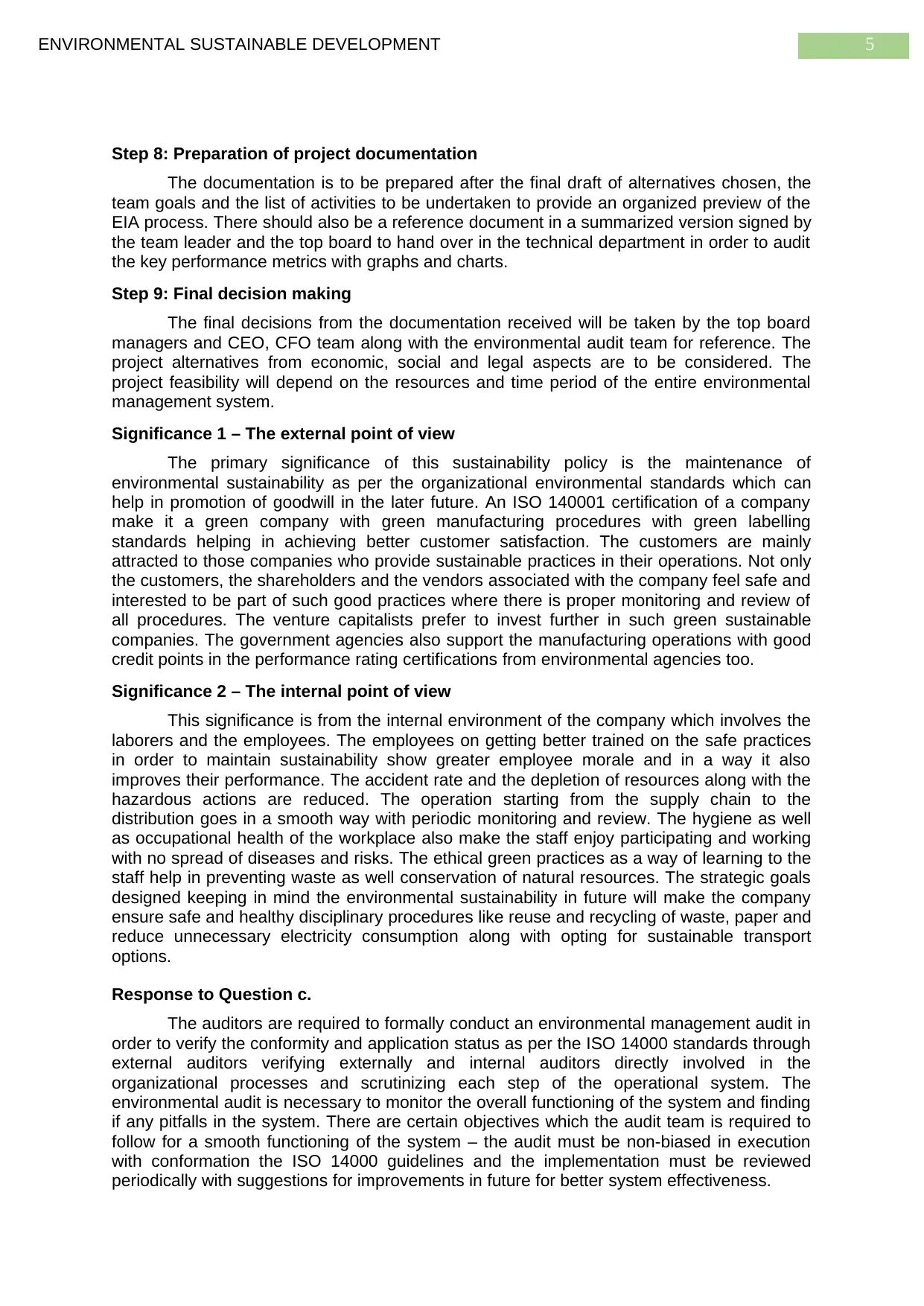
5ENVIRONMENTAL SUSTAINABLE DEVELOPMENT
Step 8: Preparation of project documentation
The documentation is to be prepared after the final draft of alternatives chosen, the
team goals and the list of activities to be undertaken to provide an organized preview of the
EIA process. There should also be a reference document in a summarized version signed by
the team leader and the top board to hand over in the technical department in order to audit
the key performance metrics with graphs and charts.
Step 9: Final decision making
The final decisions from the documentation received will be taken by the top board
managers and CEO, CFO team along with the environmental audit team for reference. The
project alternatives from economic, social and legal aspects are to be considered. The
project feasibility will depend on the resources and time period of the entire environmental
management system.
Significance 1 – The external point of view
The primary significance of this sustainability policy is the maintenance of
environmental sustainability as per the organizational environmental standards which can
help in promotion of goodwill in the later future. An ISO 140001 certification of a company
make it a green company with green manufacturing procedures with green labelling
standards helping in achieving better customer satisfaction. The customers are mainly
attracted to those companies who provide sustainable practices in their operations. Not only
the customers, the shareholders and the vendors associated with the company feel safe and
interested to be part of such good practices where there is proper monitoring and review of
all procedures. The venture capitalists prefer to invest further in such green sustainable
companies. The government agencies also support the manufacturing operations with good
credit points in the performance rating certifications from environmental agencies too.
Significance 2 – The internal point of view
This significance is from the internal environment of the company which involves the
laborers and the employees. The employees on getting better trained on the safe practices
in order to maintain sustainability show greater employee morale and in a way it also
improves their performance. The accident rate and the depletion of resources along with the
hazardous actions are reduced. The operation starting from the supply chain to the
distribution goes in a smooth way with periodic monitoring and review. The hygiene as well
as occupational health of the workplace also make the staff enjoy participating and working
with no spread of diseases and risks. The ethical green practices as a way of learning to the
staff help in preventing waste as well conservation of natural resources. The strategic goals
designed keeping in mind the environmental sustainability in future will make the company
ensure safe and healthy disciplinary procedures like reuse and recycling of waste, paper and
reduce unnecessary electricity consumption along with opting for sustainable transport
options.
Response to Question c.
The auditors are required to formally conduct an environmental management audit in
order to verify the conformity and application status as per the ISO 14000 standards through
external auditors verifying externally and internal auditors directly involved in the
organizational processes and scrutinizing each step of the operational system. The
environmental audit is necessary to monitor the overall functioning of the system and finding
if any pitfalls in the system. There are certain objectives which the audit team is required to
follow for a smooth functioning of the system – the audit must be non-biased in execution
with conformation the ISO 14000 guidelines and the implementation must be reviewed
periodically with suggestions for improvements in future for better system effectiveness.
Step 8: Preparation of project documentation
The documentation is to be prepared after the final draft of alternatives chosen, the
team goals and the list of activities to be undertaken to provide an organized preview of the
EIA process. There should also be a reference document in a summarized version signed by
the team leader and the top board to hand over in the technical department in order to audit
the key performance metrics with graphs and charts.
Step 9: Final decision making
The final decisions from the documentation received will be taken by the top board
managers and CEO, CFO team along with the environmental audit team for reference. The
project alternatives from economic, social and legal aspects are to be considered. The
project feasibility will depend on the resources and time period of the entire environmental
management system.
Significance 1 – The external point of view
The primary significance of this sustainability policy is the maintenance of
environmental sustainability as per the organizational environmental standards which can
help in promotion of goodwill in the later future. An ISO 140001 certification of a company
make it a green company with green manufacturing procedures with green labelling
standards helping in achieving better customer satisfaction. The customers are mainly
attracted to those companies who provide sustainable practices in their operations. Not only
the customers, the shareholders and the vendors associated with the company feel safe and
interested to be part of such good practices where there is proper monitoring and review of
all procedures. The venture capitalists prefer to invest further in such green sustainable
companies. The government agencies also support the manufacturing operations with good
credit points in the performance rating certifications from environmental agencies too.
Significance 2 – The internal point of view
This significance is from the internal environment of the company which involves the
laborers and the employees. The employees on getting better trained on the safe practices
in order to maintain sustainability show greater employee morale and in a way it also
improves their performance. The accident rate and the depletion of resources along with the
hazardous actions are reduced. The operation starting from the supply chain to the
distribution goes in a smooth way with periodic monitoring and review. The hygiene as well
as occupational health of the workplace also make the staff enjoy participating and working
with no spread of diseases and risks. The ethical green practices as a way of learning to the
staff help in preventing waste as well conservation of natural resources. The strategic goals
designed keeping in mind the environmental sustainability in future will make the company
ensure safe and healthy disciplinary procedures like reuse and recycling of waste, paper and
reduce unnecessary electricity consumption along with opting for sustainable transport
options.
Response to Question c.
The auditors are required to formally conduct an environmental management audit in
order to verify the conformity and application status as per the ISO 14000 standards through
external auditors verifying externally and internal auditors directly involved in the
organizational processes and scrutinizing each step of the operational system. The
environmental audit is necessary to monitor the overall functioning of the system and finding
if any pitfalls in the system. There are certain objectives which the audit team is required to
follow for a smooth functioning of the system – the audit must be non-biased in execution
with conformation the ISO 14000 guidelines and the implementation must be reviewed
periodically with suggestions for improvements in future for better system effectiveness.
⊘ This is a preview!⊘
Do you want full access?
Subscribe today to unlock all pages.

Trusted by 1+ million students worldwide
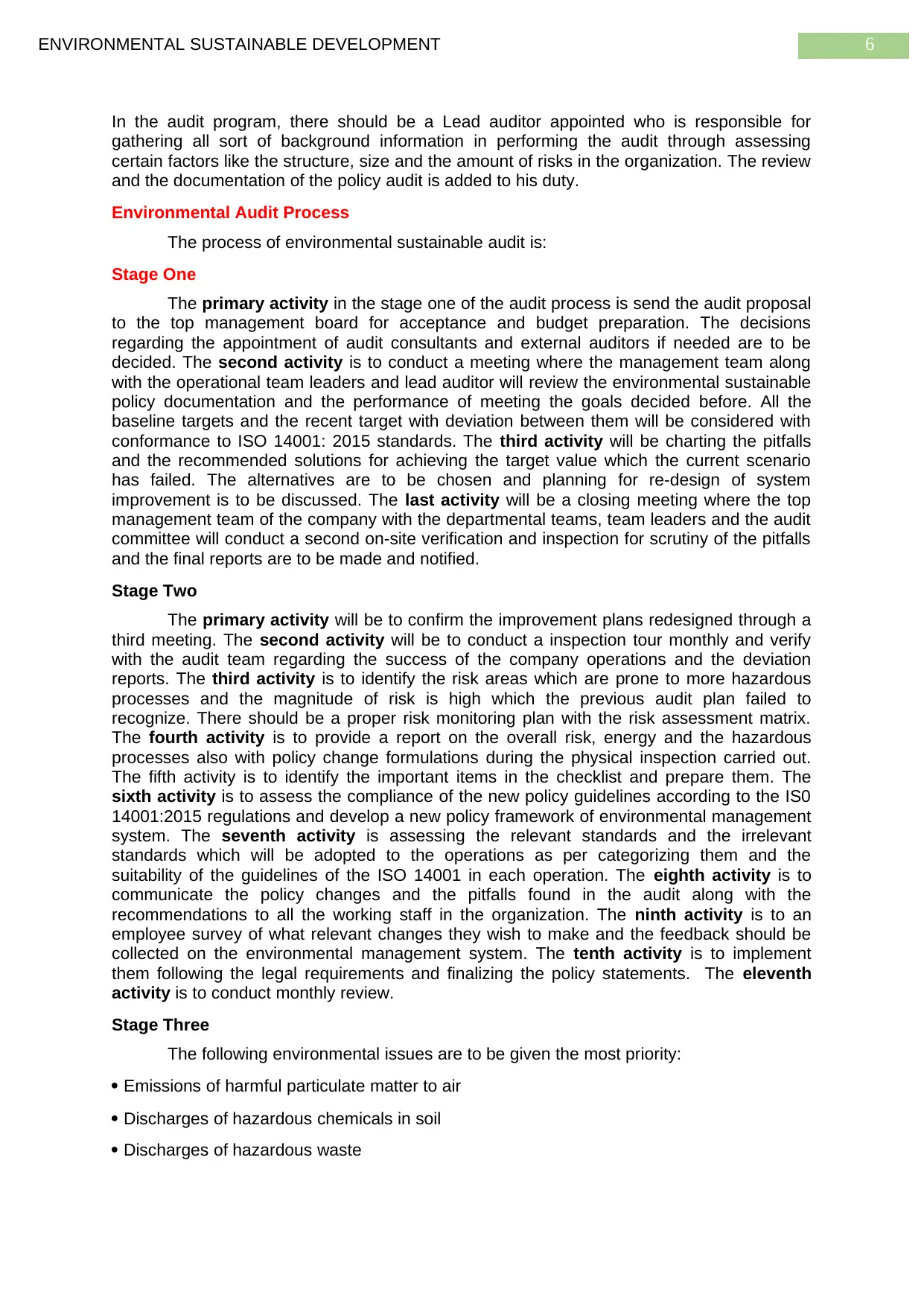
6ENVIRONMENTAL SUSTAINABLE DEVELOPMENT
In the audit program, there should be a Lead auditor appointed who is responsible for
gathering all sort of background information in performing the audit through assessing
certain factors like the structure, size and the amount of risks in the organization. The review
and the documentation of the policy audit is added to his duty.
Environmental Audit Process
The process of environmental sustainable audit is:
Stage One
The primary activity in the stage one of the audit process is send the audit proposal
to the top management board for acceptance and budget preparation. The decisions
regarding the appointment of audit consultants and external auditors if needed are to be
decided. The second activity is to conduct a meeting where the management team along
with the operational team leaders and lead auditor will review the environmental sustainable
policy documentation and the performance of meeting the goals decided before. All the
baseline targets and the recent target with deviation between them will be considered with
conformance to ISO 14001: 2015 standards. The third activity will be charting the pitfalls
and the recommended solutions for achieving the target value which the current scenario
has failed. The alternatives are to be chosen and planning for re-design of system
improvement is to be discussed. The last activity will be a closing meeting where the top
management team of the company with the departmental teams, team leaders and the audit
committee will conduct a second on-site verification and inspection for scrutiny of the pitfalls
and the final reports are to be made and notified.
Stage Two
The primary activity will be to confirm the improvement plans redesigned through a
third meeting. The second activity will be to conduct a inspection tour monthly and verify
with the audit team regarding the success of the company operations and the deviation
reports. The third activity is to identify the risk areas which are prone to more hazardous
processes and the magnitude of risk is high which the previous audit plan failed to
recognize. There should be a proper risk monitoring plan with the risk assessment matrix.
The fourth activity is to provide a report on the overall risk, energy and the hazardous
processes also with policy change formulations during the physical inspection carried out.
The fifth activity is to identify the important items in the checklist and prepare them. The
sixth activity is to assess the compliance of the new policy guidelines according to the IS0
14001:2015 regulations and develop a new policy framework of environmental management
system. The seventh activity is assessing the relevant standards and the irrelevant
standards which will be adopted to the operations as per categorizing them and the
suitability of the guidelines of the ISO 14001 in each operation. The eighth activity is to
communicate the policy changes and the pitfalls found in the audit along with the
recommendations to all the working staff in the organization. The ninth activity is to an
employee survey of what relevant changes they wish to make and the feedback should be
collected on the environmental management system. The tenth activity is to implement
them following the legal requirements and finalizing the policy statements. The eleventh
activity is to conduct monthly review.
Stage Three
The following environmental issues are to be given the most priority:
Emissions of harmful particulate matter to air
Discharges of hazardous chemicals in soil
Discharges of hazardous waste
In the audit program, there should be a Lead auditor appointed who is responsible for
gathering all sort of background information in performing the audit through assessing
certain factors like the structure, size and the amount of risks in the organization. The review
and the documentation of the policy audit is added to his duty.
Environmental Audit Process
The process of environmental sustainable audit is:
Stage One
The primary activity in the stage one of the audit process is send the audit proposal
to the top management board for acceptance and budget preparation. The decisions
regarding the appointment of audit consultants and external auditors if needed are to be
decided. The second activity is to conduct a meeting where the management team along
with the operational team leaders and lead auditor will review the environmental sustainable
policy documentation and the performance of meeting the goals decided before. All the
baseline targets and the recent target with deviation between them will be considered with
conformance to ISO 14001: 2015 standards. The third activity will be charting the pitfalls
and the recommended solutions for achieving the target value which the current scenario
has failed. The alternatives are to be chosen and planning for re-design of system
improvement is to be discussed. The last activity will be a closing meeting where the top
management team of the company with the departmental teams, team leaders and the audit
committee will conduct a second on-site verification and inspection for scrutiny of the pitfalls
and the final reports are to be made and notified.
Stage Two
The primary activity will be to confirm the improvement plans redesigned through a
third meeting. The second activity will be to conduct a inspection tour monthly and verify
with the audit team regarding the success of the company operations and the deviation
reports. The third activity is to identify the risk areas which are prone to more hazardous
processes and the magnitude of risk is high which the previous audit plan failed to
recognize. There should be a proper risk monitoring plan with the risk assessment matrix.
The fourth activity is to provide a report on the overall risk, energy and the hazardous
processes also with policy change formulations during the physical inspection carried out.
The fifth activity is to identify the important items in the checklist and prepare them. The
sixth activity is to assess the compliance of the new policy guidelines according to the IS0
14001:2015 regulations and develop a new policy framework of environmental management
system. The seventh activity is assessing the relevant standards and the irrelevant
standards which will be adopted to the operations as per categorizing them and the
suitability of the guidelines of the ISO 14001 in each operation. The eighth activity is to
communicate the policy changes and the pitfalls found in the audit along with the
recommendations to all the working staff in the organization. The ninth activity is to an
employee survey of what relevant changes they wish to make and the feedback should be
collected on the environmental management system. The tenth activity is to implement
them following the legal requirements and finalizing the policy statements. The eleventh
activity is to conduct monthly review.
Stage Three
The following environmental issues are to be given the most priority:
Emissions of harmful particulate matter to air
Discharges of hazardous chemicals in soil
Discharges of hazardous waste
Paraphrase This Document
Need a fresh take? Get an instant paraphrase of this document with our AI Paraphraser
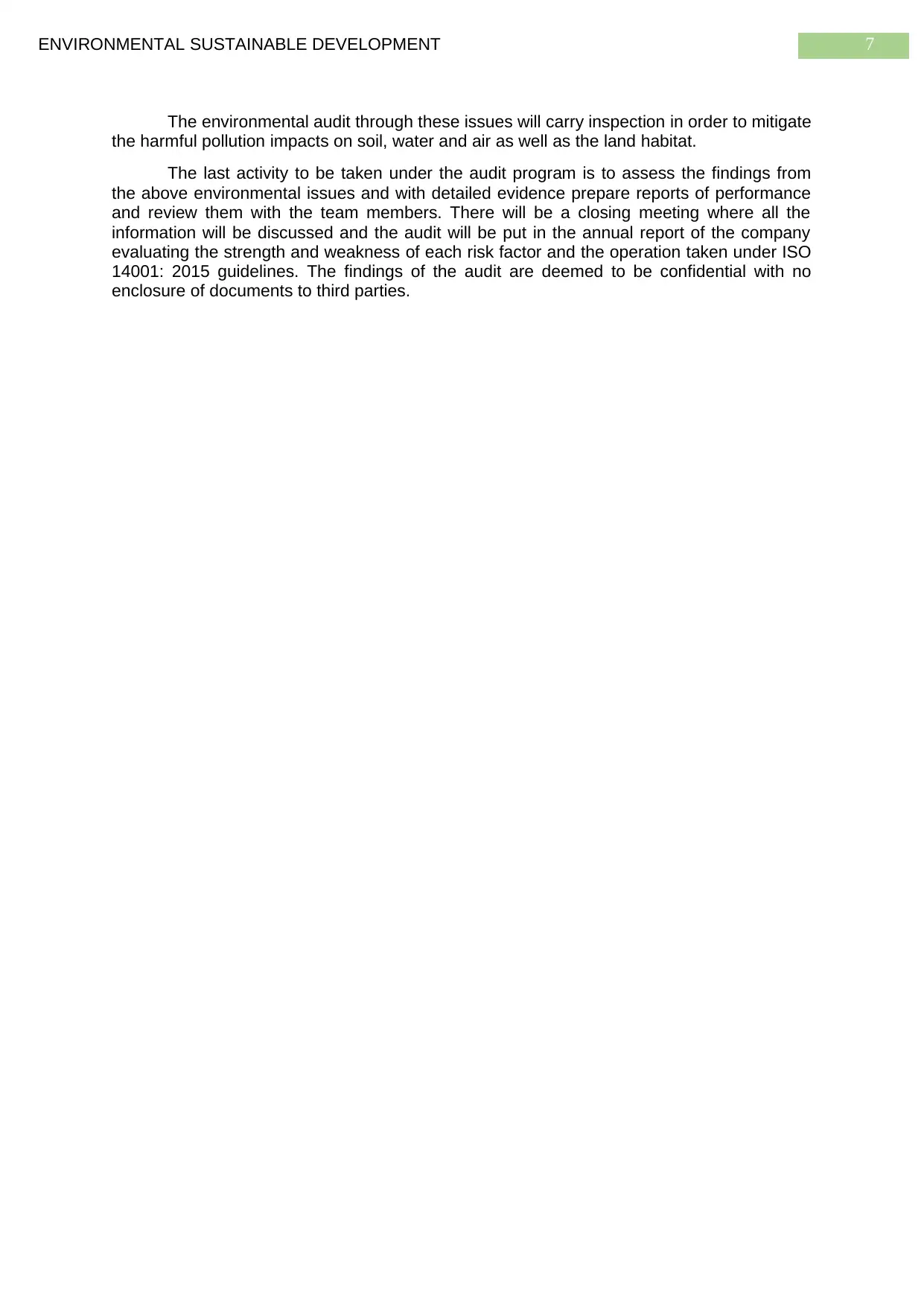
7ENVIRONMENTAL SUSTAINABLE DEVELOPMENT
The environmental audit through these issues will carry inspection in order to mitigate
the harmful pollution impacts on soil, water and air as well as the land habitat.
The last activity to be taken under the audit program is to assess the findings from
the above environmental issues and with detailed evidence prepare reports of performance
and review them with the team members. There will be a closing meeting where all the
information will be discussed and the audit will be put in the annual report of the company
evaluating the strength and weakness of each risk factor and the operation taken under ISO
14001: 2015 guidelines. The findings of the audit are deemed to be confidential with no
enclosure of documents to third parties.
The environmental audit through these issues will carry inspection in order to mitigate
the harmful pollution impacts on soil, water and air as well as the land habitat.
The last activity to be taken under the audit program is to assess the findings from
the above environmental issues and with detailed evidence prepare reports of performance
and review them with the team members. There will be a closing meeting where all the
information will be discussed and the audit will be put in the annual report of the company
evaluating the strength and weakness of each risk factor and the operation taken under ISO
14001: 2015 guidelines. The findings of the audit are deemed to be confidential with no
enclosure of documents to third parties.
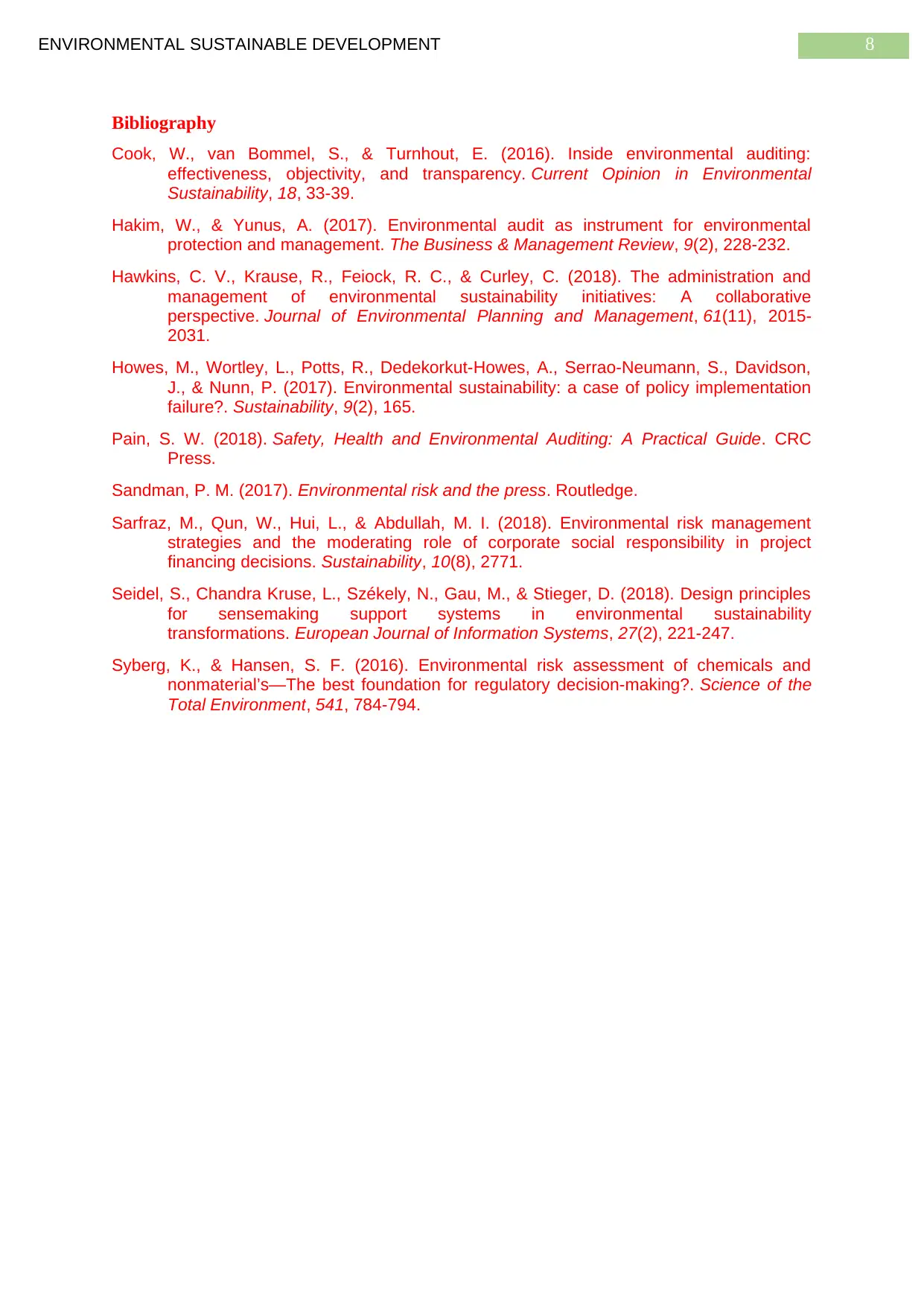
8ENVIRONMENTAL SUSTAINABLE DEVELOPMENT
Bibliography
Cook, W., van Bommel, S., & Turnhout, E. (2016). Inside environmental auditing:
effectiveness, objectivity, and transparency. Current Opinion in Environmental
Sustainability, 18, 33-39.
Hakim, W., & Yunus, A. (2017). Environmental audit as instrument for environmental
protection and management. The Business & Management Review, 9(2), 228-232.
Hawkins, C. V., Krause, R., Feiock, R. C., & Curley, C. (2018). The administration and
management of environmental sustainability initiatives: A collaborative
perspective. Journal of Environmental Planning and Management, 61(11), 2015-
2031.
Howes, M., Wortley, L., Potts, R., Dedekorkut-Howes, A., Serrao-Neumann, S., Davidson,
J., & Nunn, P. (2017). Environmental sustainability: a case of policy implementation
failure?. Sustainability, 9(2), 165.
Pain, S. W. (2018). Safety, Health and Environmental Auditing: A Practical Guide. CRC
Press.
Sandman, P. M. (2017). Environmental risk and the press. Routledge.
Sarfraz, M., Qun, W., Hui, L., & Abdullah, M. I. (2018). Environmental risk management
strategies and the moderating role of corporate social responsibility in project
financing decisions. Sustainability, 10(8), 2771.
Seidel, S., Chandra Kruse, L., Székely, N., Gau, M., & Stieger, D. (2018). Design principles
for sensemaking support systems in environmental sustainability
transformations. European Journal of Information Systems, 27(2), 221-247.
Syberg, K., & Hansen, S. F. (2016). Environmental risk assessment of chemicals and
nonmaterial’s—The best foundation for regulatory decision-making?. Science of the
Total Environment, 541, 784-794.
Bibliography
Cook, W., van Bommel, S., & Turnhout, E. (2016). Inside environmental auditing:
effectiveness, objectivity, and transparency. Current Opinion in Environmental
Sustainability, 18, 33-39.
Hakim, W., & Yunus, A. (2017). Environmental audit as instrument for environmental
protection and management. The Business & Management Review, 9(2), 228-232.
Hawkins, C. V., Krause, R., Feiock, R. C., & Curley, C. (2018). The administration and
management of environmental sustainability initiatives: A collaborative
perspective. Journal of Environmental Planning and Management, 61(11), 2015-
2031.
Howes, M., Wortley, L., Potts, R., Dedekorkut-Howes, A., Serrao-Neumann, S., Davidson,
J., & Nunn, P. (2017). Environmental sustainability: a case of policy implementation
failure?. Sustainability, 9(2), 165.
Pain, S. W. (2018). Safety, Health and Environmental Auditing: A Practical Guide. CRC
Press.
Sandman, P. M. (2017). Environmental risk and the press. Routledge.
Sarfraz, M., Qun, W., Hui, L., & Abdullah, M. I. (2018). Environmental risk management
strategies and the moderating role of corporate social responsibility in project
financing decisions. Sustainability, 10(8), 2771.
Seidel, S., Chandra Kruse, L., Székely, N., Gau, M., & Stieger, D. (2018). Design principles
for sensemaking support systems in environmental sustainability
transformations. European Journal of Information Systems, 27(2), 221-247.
Syberg, K., & Hansen, S. F. (2016). Environmental risk assessment of chemicals and
nonmaterial’s—The best foundation for regulatory decision-making?. Science of the
Total Environment, 541, 784-794.
⊘ This is a preview!⊘
Do you want full access?
Subscribe today to unlock all pages.

Trusted by 1+ million students worldwide
1 out of 9
Related Documents
Your All-in-One AI-Powered Toolkit for Academic Success.
+13062052269
info@desklib.com
Available 24*7 on WhatsApp / Email
![[object Object]](/_next/static/media/star-bottom.7253800d.svg)
Unlock your academic potential
Copyright © 2020–2025 A2Z Services. All Rights Reserved. Developed and managed by ZUCOL.




